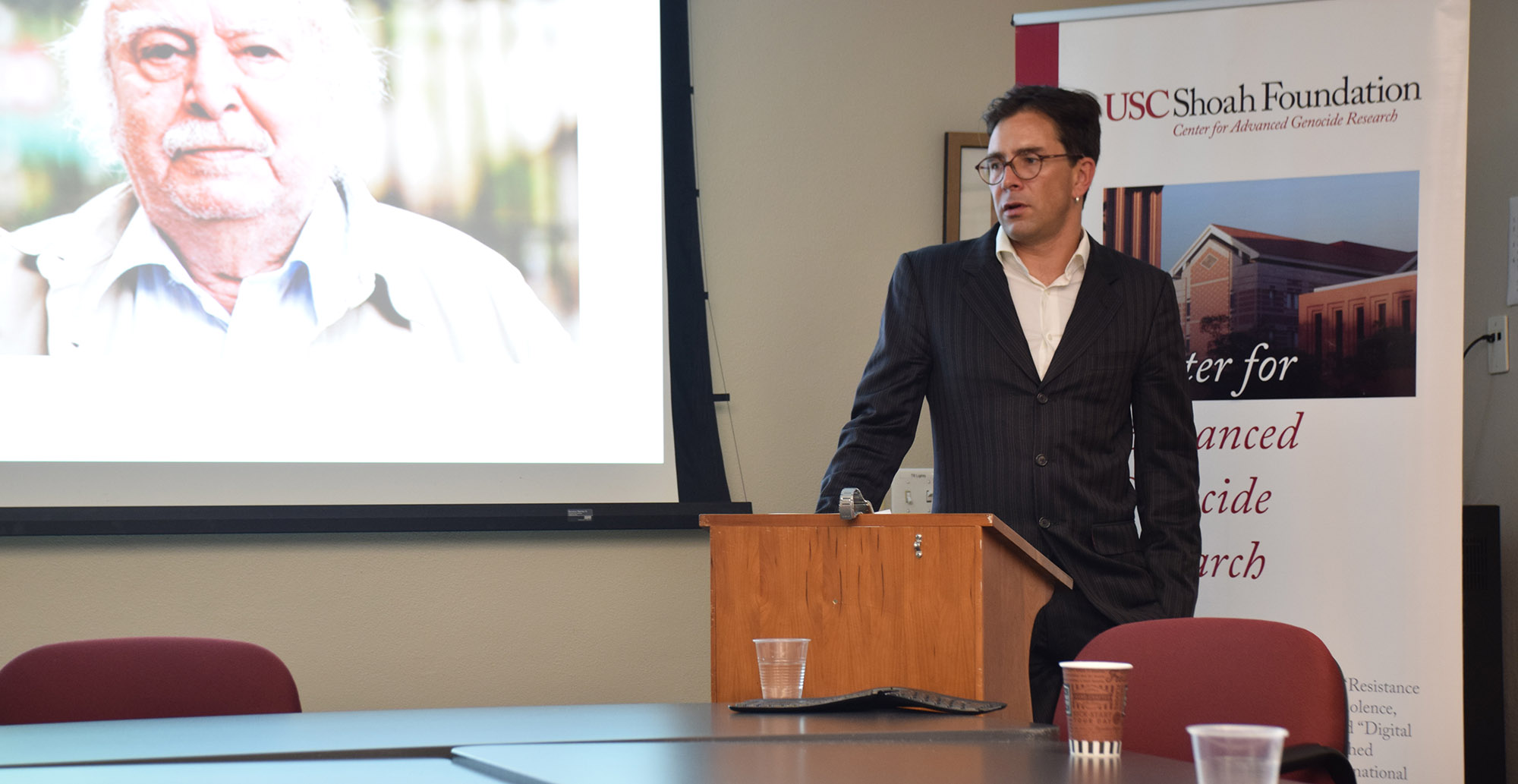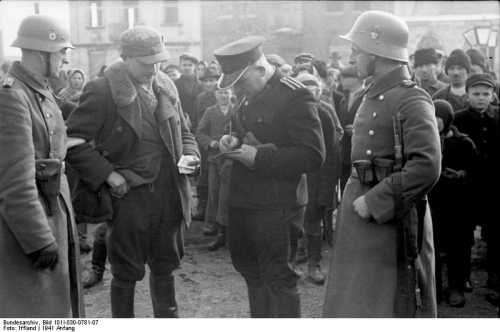Alexander Korb Lecture Summary

Alexander Korb (University of Leicester)
"Collaborators: Exploring Participation in the Holocaust by Non-Germans in Eastern Europe"
April 20, 2017
In this lecture, Professor Alexander Korb explores the phenomenon of collaboration, drawing from a number of country case studies in Eastern and Southeastern Europe. He argues that we need to include Jewish perspectives in order to understand collaboration, because Jews knew their collaborating neighbors much better than the Germans did.
Alexander Korb, the 2016-2017 Center Research Fellow and director of the Stanley Burton Centre for Holocaust and Genocide Studies at the University of Leicester, gave a public lecture at the USC Shoah Foundation Center for Advanced Genocide Research focusing on his research on collaboration in the Holocaust in eastern and southeastern Europe, which is the topic of his current book project A Multitude of Lethal Attacks: Collaboration and Mass Violence in Southeastern Europe, 1940-1946.
Professor Korb began his lecture by reflecting on the date of the lecture – April 20th, Hitler’s birthday. The dominance, power, and influence of Hitler’s image and legacy relate to the topic of the lecture, Korb argued, since people tend to view collaboration as very vertical – from the bottom to the top. Collaborators, or local non-German perpetrators, have been viewed as German puppets or as madman accomplices. Professor Korb’s research on collaboration and perpetration in southeastern Europe challenges this German-centric and Hitler-centric perspective. During the Second World War in Bosnia, for example, local dynamics shaped violence much more than Hitler did.

He then reflected on the photograph above, which reveals the dynamics between Germans and local perpetrators. The photo captures an encounter between a Polish policeman and a Jewish man, supervised by German soldiers. The photo sparks all sorts of questions, Professor Korb said. What is the language they’re speaking? If they’re speaking in Polish, do the Germans understand? Does the Jewish man speak Polish? Is the policeman translating? Korb pointed out that the leeway the Polish policeman and German solider have in this scenario is more restricted than in most cases because of all the people surrounding the two men in the photo – all those Polish ears and eyes that are overhearing and overseeing this encounter.
Professor Korb argued that there was a wide variety of motivations for non-Germans to become perpetrators, which could range from private and monetary agendas to politically-motivated, nationalist agendas.
Alexander Korb’s research focuses on independent states in the southeastern part of Europe during World War II – Bulgaria, Romania, Croatia, Hungary, Slovakia, and Finland, among others. The degree of independence varied in this region from nominally independent to truly independent. Attention to case studies from this region shed light on non-German agendas, patterns, and practices on the ground that expand our understanding of World War II and Holocaust. The inclusion of Jewish perspectives that he wants to find in the USC Shoah Foundation Visual History Archive during his residency is critical to this research.
This research decenters the dominant German-centric or Hitler-centric perspective. In a similar vertical conception, many people think of Germany in control or on the top in Berlin and then non-German perpetrators in these other countries beneath them and reporting back. However, there are other significant relationships other than between these states and Germany. These countries have long histories of relationships with each other that include tensions and competing agendas. Professor Korb argued that a transnational history of collaboration is long overdue.
Professor Korb described that collaboration can be examined at four different levels: international or global, national, regional, and local or village-level. These levels are intertwined, and it is impossible to study one level alone.
When exploring non-German local agendas, collaborators are most often depicted as puppets that are remote controlled from Germany or as local nationalists who are out of control. There is significant explanatory power in keeping the analysis of non-German perpetrators on such an individual level, Korb asserted. This allows the focus to be shifted away from local communities, regions, or nations, and the guilt is instead shifted to the Germans or to a small group of brutal fanatics. The actual picture is far more complex.
The southeast was a very ethnically heterogeneous part of Europe, and some of the powers that be in these areas desired ethnic homogeneity, such as in Romania, Bulgaria, and Yugoslavia. World War II presented the opportunity to pursue this goal. Through alliance with the Germans, these countries could achieve goals they had already defined. Thus, there were not only German aims imposed on these countries. This is why attention to regional histories and geographies need to be taken seriously, Korb argued.
The “Jewish question” dealt with just one of several minority groups that national leaders in this region wanted to handle. So who were these leaders? Korb described that many were highly educated academics, well-connected, with German university degrees. They were not madmen.
Professor Korb then turned to a close case study of Hanaczow in Eastern Poland to illuminate the complex relationships on the ground. (He discovered survivor testimonies about Hanaczow during his first month of research in the Visual History Archive.)
He then focused on the dynamics of violence in Romania and Croatia. In Romania, for example, the Holocaust began independent of the Germans. It started in 1940 with a pogrom that did not involve German perpetrators. Romanian perpetrators targeted gypsies. In Croatia, the Ustasha fascist government wanted an ethnically homogeneous state and 300,000 Serbs were expelled, unleashing civil war. State persecution of Jews and Roma was radicalized, and soon this spread, affecting other minorities. Local attempts at ethnic cleansing sparked resistance, resulting in local civil wars.
Professor Korb asserted that in some cases in southeastern Europe, while the motives of groups of perpetrators differed, their ultimate goals were the same, leading to coalitions of perpetrators. Coalitions of victim groups also formed, Korb explained, in Greece, Croatia, Eastern Poland, and Western Ukraine.
Local case studies, Korb emphasized, are critical to revealing the dynamics on the ground, and Jewish testimonies – such as those in the Visual History Archive -- enable us to understand those local dynamics. Polish archives have collected testimonies as well. (Professor Korb cautioned that scholars cannot rely on Holocaust testimonies alone.) Jewish perspectives are fruitful for research because Jews knew with whom they were dealing. They knew the perpetrators’ agendas and whether they could be trusted. Understanding the dynamics between non-German perpetrators and Jewish victims, between German perpetrators and non-German perpetrators, are all aided by including Jewish perspectives.
Attention to World War II and the Holocaust in southeastern Europe helps to “Europeanize” the Holocaust, moving away from a German-centric perspective. Additionally, Professor Korb argued, it opens our minds to different timelines of the Holocaust. Each timeline in Southeastern Europe is different. It also helps us to explore the complexities of when violence begins and ends, which Professor Korb discussed at the conclusion of his lecture. There is a prevalent notion that the war starts, the German army enters particular regions, and conflict starts. However, examining violence on regional and local levels complicates this picture. Violence often starts before the Germans even arrive. Equally complicated is the question of when does violence end. The end of World War II does not mean the end of violence. Civil wars continue well into 1946 in a number of these states. Local killings of Jews did not end in 1945 everywhere. Exploring this history in Southeastern Europe challenges our notions about when and how violence comes to rest.
In the lengthy Q&A following his lecture, Professor Korb discussed more of the dynamics of violence in Croatia, the personal agendas that motivated non-German perpetrators (such as economic benefits and securing property), his description of coalitions of perpetrators, and the use and usefulness of the term “genocide”.
Summary by Martha Stroud